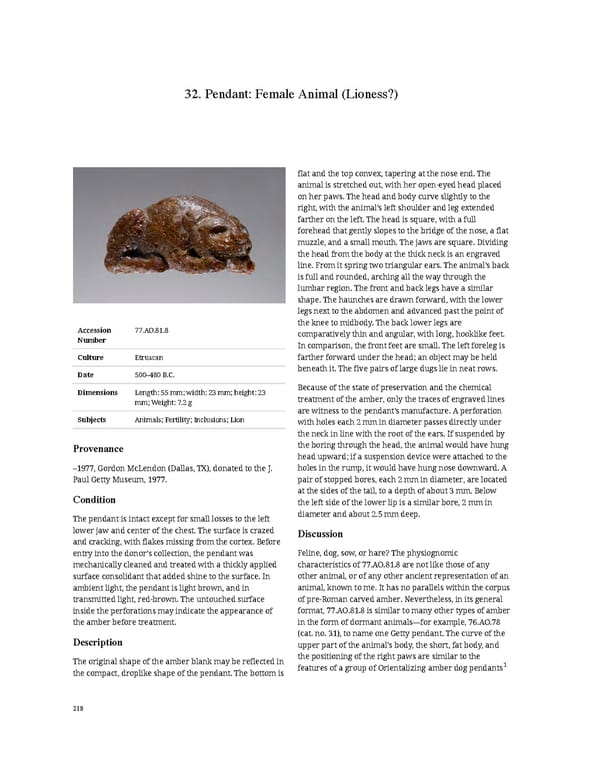32. Pendant: Female Animal (Lioness?) flat and the top convex, tapering at the nose end. The animal is stretched out, with her open-eyed head placed on her paws. The head and body curve slightly to the right, with the animal’s left shoulder and leg extended farther on the left. The head is square, with a full forehead that gently slopes to the bridge of the nose, a flat muzzle, and a small mouth. The jaws are square. Dividing the head from the body at the thick neck is an engraved line. From it spring two triangular ears. The animal’s back is full and rounded, arching all the way through the lumbar region. The front and back legs have a similar shape. The haunches are drawn forward, with the lower legs next to the abdomen and advanced past the point of the knee to midbody. The back lower legs are Accession 77.AO.81.8 comparatively thin and angular, with long, hooklike feet. Number In comparison, the front feet are small. The left foreleg is Culture Etruscan farther forward under the head; an object may be held Date 500–480 B.C. beneath it. The five pairs of large dugs lie in neat rows. Dimensions Length: 55 mm; width: 23 mm; height: 23 Because of the state of preservation and the chemical mm; Weight: 7.2 g treatment of the amber, only the traces of engraved lines are witness to the pendant’s manufacture. A perforation Subjects Animals; Fertility; Inclusions; Lion with holes each 2 mm in diameter passes directly under the neck in line with the root of the ears. If suspended by Provenance the boring through the head, the animal would have hung head upward; if a suspension device were attached to the –1977, Gordon McLendon (Dallas, TX), donated to the J. holes in the rump, it would have hung nose downward. A Paul Getty Museum, 1977. pair of stopped bores, each 2 mm in diameter, are located Condition at the sides of the tail, to a depth of about 3 mm. Below the left side of the lower lip is a similar bore, 2 mm in The pendant is intact except for small losses to the left diameter and about 2.5 mm deep. lower jaw and center of the chest. The surface is crazed Discussion and cracking, with flakes missing from the cortex. Before entry into the donor’s collection, the pendant was Feline, dog, sow, or hare? The physiognomic mechanically cleaned and treated with a thickly applied characteristics of 77.AO.81.8 are not like those of any surface consolidant that added shine to the surface. In other animal, or of any other ancient representation of an ambient light, the pendant is light brown, and in animal, known to me. It has no parallels within the corpus transmitted light, red-brown. The untouched surface of pre-Roman carved amber. Nevertheless, in its general inside the perforations may indicate the appearance of format, 77.AO.81.8 is similar to many other types of amber the amber before treatment. in the form of dormant animals—for example, 76.AO.78 Description (cat. no. 31), to name one Getty pendant. The curve of the upper part of the animal’s body, the short, fat body, and The original shape of the amber blank may be reflected in the positioning of the right paws are similar to the features of a group of Orientalizing amber dog pendants1 the compact, droplike shape of the pendant. The bottom is 218
 Ancient Carved Ambers in the J. Paul Getty Museum Page 227 Page 229
Ancient Carved Ambers in the J. Paul Getty Museum Page 227 Page 229